

|
|








|
ICCS 2007 : Keynote Abstract Langtangen
Computational Modeling of Huge Tsunamis from Asteroid Impacts
Hans Petter LangtangenScientific Computing Department at the Simula Research Laboratory
and Department of Informatics, University of Oslo
Throughout its history of existence the Earth have been hit by asteroids and comets. Impacts from the largest objects may have caused dramatic environmental changes. For example, impacts are now commonly believed to explain sudden mass-extinction of species, with the Chicxulub impact (65 Mya) as the prime example. In marine impacts giant tsunamis may be generated. These tsunamis may have disastrous regional and, possibly, even global effects. In this talk we look more closely at a specific marine impact that took place 142 million years ago in the Barents sea. The impact occured in a depth of about 400m and formed a crater with a diameter of 40 km.
We outline how such a multi-disciplinary, multi-physics, and multi-scale problem can be attacked, and what kind of mathematical models and numerical methods we have applied for simulating the impact as well as the tsunami generation and propagation. Key topics include finite element/difference methods for long wave equations, domain decomposition methods, and parallellization. We thereafter show results from the simulations and compare the event with the the tragic earthquake-generated tsunami on Dec 26, 2004 in the Indian Ocean. Finally, we discuss shortcomings of the models and suggest possible improvements.

